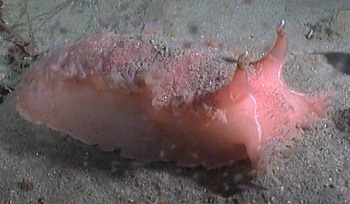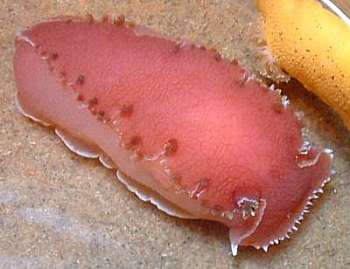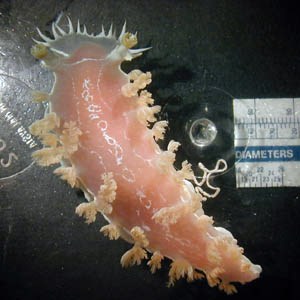

Tritonia diomedea
Bergh, 1894
Order: NUDIBRANCHIA
Suborder: DENDRONOTINA
Family: Tritoniidae
DISTRIBUTION
West Coast of North America from Aleutian Islands, Alaska to Bay of Panama. (also Japan).
PHOTO
Upper: In sand near Monterey Breakwater, California, 18m. Approx 150mm long. Photo: Clinton Bauder.
Lower: Monterey Bay, California, at about 200 feet. Approx 75mm long. Photo: Steve Johnston.
Broad tritoniid in which the foot is wider than the dorsum. The oral veil is wider than the foot and has a series of digitiform sensory tentacles along the anterior edge. There are 20-30 small branched gills along the edge of the dorsum. The body ranges in colour from a translucent white, through pink to quite a deep red. There is a narrow opaque white line along the edge of the foot, dorsum, edge of the rhinophore sheath and posterior edge of the oral veil.
This species lives in sand and feeds on sea pens (Pennatulacea) such as Renilla. It grows to approx 200mm in length, and is found from the shallow sublittoral to 750m.
Reference:
• Bergh, R. (1894) Reports on the dredging operations off the West Coast of Central America to the Galapagos, to the West Coast of Mexico, and in the Gulf of California, in charge of Alexander Agassiz, carried on by the U.S. Fish Commission Steamer "Albatross", during 1891, Lieut. Commander Z.L.Tanner, U.S.N., Commanding. XIII. Die Opisthobranchien. Bulletin of the Museum of Comparative Zoology 25(10): 125-233.
Rudman, W.B., 1998 (June 5) Tritonia diomedea Bergh, 1894. [In] Sea Slug Forum. Australian Museum, Sydney. Available from http://www.seaslugforum.net/find/tritdiom
Related messages
Re: Tritonia diomedea from Puget Sound
February 19, 2008
From: Paul Katz
Concerning message #16119:
In response to question of color variation in Tritonia diomedea. I have worked with them for 15 years and have noticed significant variations that seem to be correlated with the location that they are found and possibly on their food source. They vary from a peach color, to orange, deep pink. We have speculated that it depends upon which food source they are feeding on. The Tritonia that feed on sea pens (Ptilosarcus) are more orange than the ones that feed on sea whips (Virgularia). Once, I saw some from California that may have been feeding on sea pansies. They were deep pink.
Paul Katz
pkatz@gsu.edu
Katz, P.S., 2008 (Feb 19) Re: Tritonia diomedea from Puget Sound. [Message in] Sea Slug Forum. Australian Museum, Sydney. Available from http://www.seaslugforum.net/find/21332Dear Paul,
Thanks for these valuable observations. I concur completely.
Best wishes,
Dave Behrens
Re: Tritonia diomedea from southern California
November 6, 2007
From: Sheri Bauer

Concerning message #19106:
I think this is a color variation of Tritonia festiva? It was moving along the sandy bottom. Kind of FAT (width) I thought for a nudibranch but very neat white linear lines around the bottom of it's foot? and running from it's antennae (?) to the side/bottom.
Locality: Malibu - Point Dume, 25 feet, California, USA, Pacific Ocean, 14 October 2007, sandy bottom intertidal. Length: 4 inches. Photographer: Sheri Bauer.
Sheri Bauer
sheri.bauer@pepsi.com


Hi Sheri,
Wow. Your specimen here does nothing to clear up the confusion about the large specimens of T. festiva, lacking the usual white network, that we are seeing up in Washington. In fact I would have to say that yours is Tritonia diomedea.
I base this identification on your specimens size, the number of digitiform processes on the frontal veil, and the strong white band on the foot. One big piece of evidence is that your specimen is covered with sand, suggesting it has been burrowing after sea pens. I realize this is not conclusive, but I have only seen this with Tritonia diomedea.
Thanks for sharing this,
Dave Behrens
Tritonia diomedea from Puget Sound
March 17, 2006
From: Jan Kocian

Hi Bill.
Looking through Forum messages about Tritonia diomedea, I notice that the one I encountered last May here on Whidbey is of darker red color. I thought I share this.
Locality: artificial reef, 30 feet, Washington USA, Puget Sound, NE Pacific Ocean, 12 May 2005, sand. Length: 30 mm. Photographer: Jan Kocian.
Jan
honkoc@hotmail.com



Dear Jan,
These big animals must be a sight crawling across the sand. Do you find them out during the day or only the night? I assume the sea pens they feed on only emerge at night or on very dull days.
Best wishes,
Bill Rudman
Tritonia diomedea from California
July 22, 2004
From: Steve Johnston

I'm interested to know if anyone recognizes this pink slug. It was collected in Monterey Bay [California] at about 200 feet depth on a sandy bottom. It came up attached to some other items we were collecting. It's about 3 inches long, and the color in the photo is true. It's in a display dish with Anisodoris nobilis.
Any help would be greatly appreciated.
Steve Johnston
sjohnston@mbayaq.org
Johnston, S., 2004 (Jul 22) Tritonia diomedea from California. [Message in] Sea Slug Forum. Australian Museum, Sydney. Available from http://www.seaslugforum.net/find/12592
Dear Steve,
This is Tritonia diomedea. The white edging to the oral veil, mantle, rhinophore pockets and foot are very charcteristic.
Best wishes
Bill Rudman
Re: Tritonia diomedea - big puzzle
January 18, 2003
From: Cynthia Trowbridge
Dear Russell,
I am interested to hear of your "adult Tritonia" issue. As an ecologist, I can think of several potential explanations of the pattern:
1. Low recruitment and long lifespan will result in such a pattern. In Oregon, researchers wondered for a long-time where the juvenile and sub-adult stages were of Pisaster, our common sea star; we have lots of adults but where are the younger age-classes? It turns out that recruitment can be episodic in time and space. We find juvenile sea stars abundantly at some sites in some years. Another example would be the chiton Cryptochiton. In 20 years on the Oregon, I saw my first "juvenile" this past summer during the beginning on an El Nino event. There are high densities of adults but nothing <10-15 cm.
2. Rapid growth will also result in such a pattern. In Oregon, Placida dendritica on Bryopsis grows incredibly fast so unless you are lucky enough to see it a few days post-larval settlement, you would assume that there were no juveniles. Recruitment experiments, however, indicate that there is high recruitment.
3. Differential habitat-use (e.g. ontogenetic changes in feeding habits) can also result in such a pattern.
4. Size-specific predation can also result in such a pattern. Despite the dogma that nothing eats nudibranchs, many fishes, crabs, sea spiders, and even mites do eat juvenile or small opisthobranchs. If there is intense predation pressure within the beds, there could be the apparent exclusion of entire size-classes or an entire local population of nudibranchs.
I have no specific information about Tritonia but would suggest you think about life history parameters (recruitment, growth, and longevity) as well as ecological effects (water flow patterns on recruitment, predation on certain stages) as possible explanations.
Good luck!
Cordially,
Cynthia
trowbric@onid.orst.edu
Tritonia diomedea - big puzzle
January 17, 2003
From: Russell Wyeth


Hello,
I'm a graduate student working at the University of Washington. We do a lot of field work with the giant orange nudibranch, Tritonia diomedea. We've been struggling with a big puzzle for some time now, and I thought I'd ask around to see if anyone had any insight or observations to help us. Basically, the problem is that we never see small animals. We dive a lot on sea pen beds, and there are lots of larger animals ... say 7cm and longer. Not surprising since Tritonia eats sea pens. But smaller animals are incredibly rare. So rare, that they really must be somewhere else -- its not that they are small and harder to see. Has anyone ever seen significant densities of smaller Tritonia diomedea? Anyone observed them feeding on anything but sea pens or sea whips? I'd suspect, from their congeners feeding habitats, that perhaps they start out feeding on a deeper soft coral, but I know of no such observations.
Another strange observation is that although Tritonia only eats sea pens and sea whips, there are more sea pen and sea whip beds without Tritonia than beds with the slugs (that we've observed so far). As far as we can tell, the habitats are the same -- same substratum, roughly the same current flow speeds, same densities of sea pens, yet there are no slugs in 3 or 4 such beds, for every one that has slugs. And its not just an that there are 'blooms' of Tritonia -- the same sea pen beds continue to have slugs year after year.
Does anyone have any thoughts on what might be unusual factors regulating population densities?
The upper picture is of T. diomedea with sea pens, and the lower photo is of the closely related species Tritonia festiva which could be mistaken for smaller Tritonia diomedea, but which has broader habitat and food tastes.
Thanks in advance,
Russell
rwyeth@u.washington.edu
Dear Russell,
This is an interesting question. The obvious comment, which you address in your message, is that the juveniles are hiding somewhere. Is it possible they are living in the sand and only feeding on 'subterranean' or rather 'subsand' parts of the sea pens? Secondly does T. diomedea have an annual life cycle, if so then it is unlikely you would see big and very small animals together.
James Murray describes some aspects of the biology of this species on Mike Miller's Slug Site [http://slugsite.us/bow/nudiwk76.html] which I summarise below:
=========
"It feeds on pennatulacean cnidarians- Ptilosarcus gurneyi, Virgularia, and Stylatula elongata in Washington and British Columbian waters, and Acanthoptilum in Californian waters as deep as 200 m. .... will also feed on the Californian sea pansy Renilla koellikeri in the laboratory although it is unknown if they do so in nature. It appears that in many cases a geographically isolated group of Tritonia will eat only one prey species, and this prey species varies between groups. T. diomedea lives among beds of these soft corals on flat or gently sloping soft bottoms of sand or silt.
T. diomedea found among Virgularia tend to be smaller (0.5-20 cm) than those found among Ptilosarcus (8-30 cm). To my knowledge, no Tritonia diomedea under 5 cm has ever been found in a Ptilosarcus bed, although it metamorphoses from a veliger larva into a slug ~1 mm long. Whether smaller slugs are difficult to locate, or are migrating from elsewhere after growing is unknown. Those found among Ptilosarcus tend to be orange (like Ptilosarcus), with distinct tubercles on the dorsum, while those found among Virgularia tend to be redder in hue, from brick red to pale pink, and have a smoother dorsum (MacFarland 1966 for color illustration). It is unknown whether these two forms are genetically distinct, but the two forms will mate and do produce motile veligers." ... James Murray -University of Central Arkansas
==========
From this it seems that James Murray has also found it impossible to find juveniles on Ptilosarcus although they are found on Virgularia. Certainly looks like an interesting problem for someone to study
Best wishes,
Bill Rudman
Tritonia diomedea from Monterey, CA
March 6, 2002
From: Clinton Bauder


Hi Bill,
Here is Tritonia diomedea. It was seen in about 18M of water adjacent to the Monterey Breakwater, California. It is a large slug, about 150mm long.
Clinton
gecko1@apple.com
Bauder, C., 2002 (Mar 6) Tritonia diomedea from Monterey, CA. [Message in] Sea Slug Forum. Australian Museum, Sydney. Available from http://www.seaslugforum.net/find/6320Thanks Clinton,
This species has similar adaptations for living in sand as the other species I compare with with Euselenops luniceps. In particular it has a very broad foot, and a wide oral veil with sensory tentacles along the edge.
Best wishes,
Bill Rudman
Re: Food source for Tritonia diomedea
June 25, 1998
From: Kerry Clark
Paul,
You might try Renilla ("Sea Pansy") which occur in inshore waters in Georgia and the Carolinas; these are in the same order as Ptilosarcus (Pennatulacea). The Tritonia may require a training period to learn to eat the new food source, though. There are other Tritonia in the SE US that eat various gorgonians, but I am afraid that collection of gorgonians in quantity may not be environmentally wise. Renilla can be collected by dredging (or hand-picking at low tide), and you might check with shrimpers on the Georgia coast, as these animals may be a by-catch component, so would otherwise be wasted. It is also possible that shrimpers collect other sea-pens which might be perfectly acceptable to Tritonia diomedia.
Kerry Clark
Kerry Bruce Clark, Ph.D., F.A.A.A.S.
Professor of Biological Sciences, Assoc. Dept. Head (Graduate Coordinator)
Florida Institute of Technology, Melbourne, FL 32901-6988
Phone 1-407-674-8195
kclark@iu.net
Clark, K., 1998 (Jun 25) Re: Food source for Tritonia diomedea. [Message in] Sea Slug Forum. Australian Museum, Sydney. Available from http://www.seaslugforum.net/find/134Food source for Tritonia diomedea
June 5, 1998
From: Paul Katz
Hi,
I am a neurobiologist who works on a nudibranch species, Tritonia diomedea, found on our side of the Pacific ocean. We have these animals collected for us and transported to Atlanta, where we keep them in artificial seawater tanks. To keep the animals alive for many weeks or months, we feed them sea pens (Ptilosarcus gurneyi), which are also collected for us. My question is does anybody know of an alternative food source that we can more easily obtain than seapens. Are there any similar species that are cultured?
Does anybody else have a similar problem?
Thanks for your help.
Paul Katz
Atlanta, GA,
USA
pkatz@gsu.edu
Katz, P., 1998 (Jun 5) Food source for Tritonia diomedea. [Message in] Sea Slug Forum. Australian Museum, Sydney. Available from http://www.seaslugforum.net/find/133